In the wake of Pope Francis's death, the College of Cardinals is already preparing to gather for the conclave next week to hold what could be the most important event in the catholic religion for the next couple of decades: Picking a new pope.
During these days, Catholics pray for the Holy Spirit to give their leaders enough understanding and light to leave all differences aside and pick the best candidate to rule the church—effectively merging the spiritual and terrestrial realms to come up with what has also historically been a very political decision.
So who’s the odds-on favorite to be the next pope?
We queried 13 of the world's most advanced artificial intelligence models and tasked them with evaluating and predicting which cardinal is best positioned to lead the Catholic Church into its next chapter. (Though popes don’t have to be chosen from the ranks of cardinals, historically this has been the case since the 14th century—the movie "Conclave" notwithstanding.)
Despite varying methodologies and perspectives, the AI systems pretty much concluded that Cardinal Luis Antonio Tagle of the Philippines would not only be the best candidate to guide the Church through its current challenges, but that he would indeed be the next pope.
Interestingly, that pick differs from the leading prediction markets, including Polymarket, Kalshi and Myriad (disclosure: Myriad comes from Decrypt's parent company, DASTAN). While Tagle is a strong contender in those markets, human bettors were predicting that Cardinal Pietro Parolin—or someone else entirely—will be the next pope.
This digital "conclave" offers an interesting window into how different analytical systems process the same complex question, and how they can arrive at remarkably similar conclusions even when approaching the problem from distinct angles.
The 'Digital College of Cardinals' picks Tagle
The analysis involved thirteen top-tier AI models: Claude, GPT-4o, GPT-4.5, Perplexity, Mistral, Meta AI, Grok-3, Gemini, Qwen 2.5 Max, You.com Research, DeepSeek R1, Microsoft Copilot, and even an open-source deep research agent representing the most advanced large language models currently available.
Each agent has the capability to browse the web for information and provide a combination of reasoning capabilities and/or a deep research mode.
We started with one base prompt: “Act as an expert in theology, Catholic geopolitics, and modern Catholicism. Evaluate all the options for the next pope and predict who will be the next pope and why. Also include who could be the best pope and why.”
This base prompt was further enhanced using the “concept elevation” technique that makes a prompt detailed enough for an AI agent to execute its task more accurately. That new prompt was fed to all the digital agents under the same conditions.
These two questions ("Who will be the next pope?" and "Who would be the best pope?"), yielded different results, though there was significant overlap.
Each AI system brought its own strengths and analytical frameworks to the task. Some focused heavily on statistical probability and historical conclave patterns, while others emphasized theological positioning, regional representation, or specific Church challenges. Several presented comprehensive dossiers on each candidate, analyzing their viability through multiple lenses.
All the reports are available in our Github repository.
Despite these different approaches, almost all the models included Cardinal Tagle in their shortlists, with Cardinals Pietro Parolin and Péter Erdő closely behind
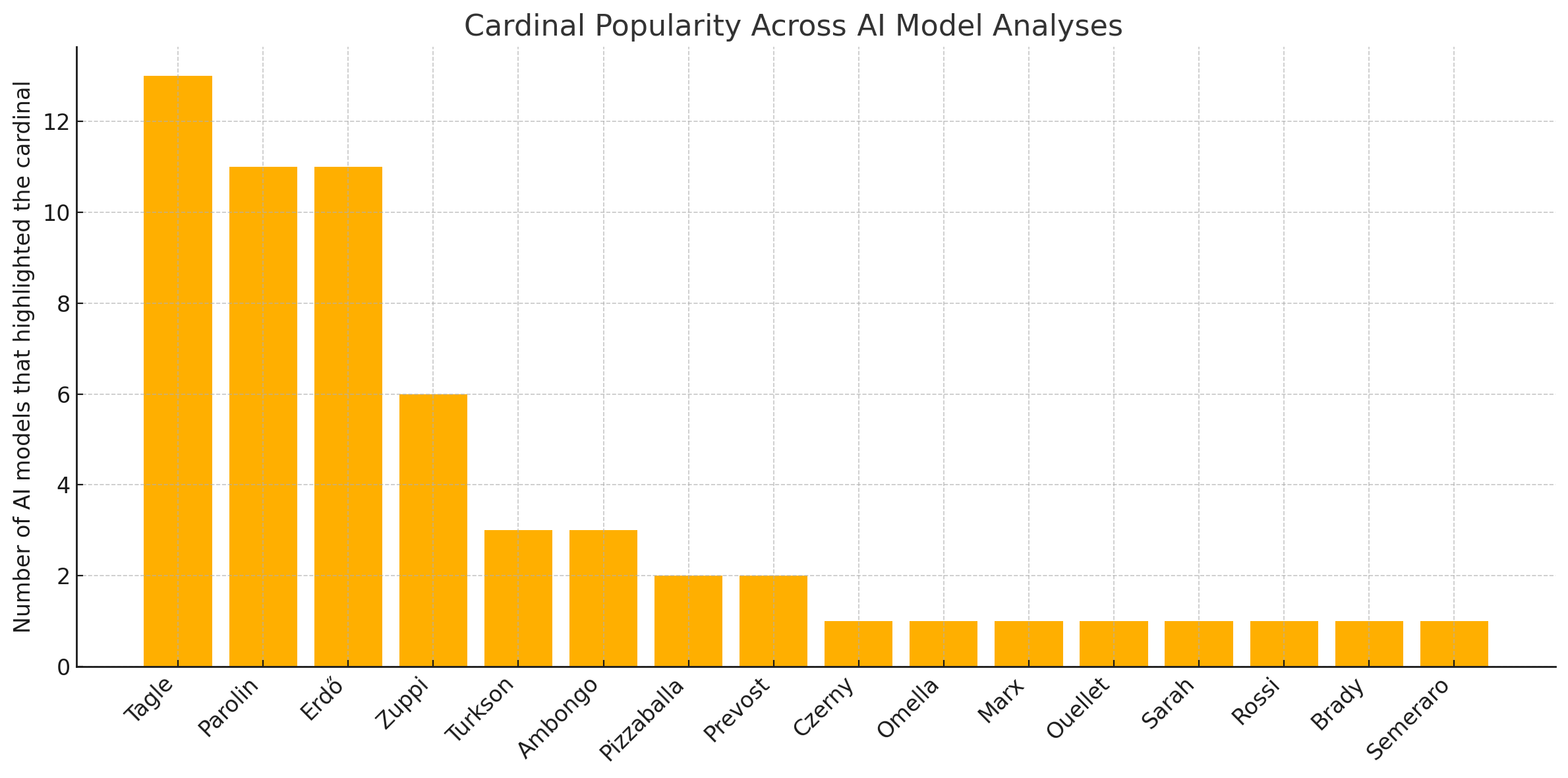
Multiple AI analyses emphasized Tagle's communication skills and media savvy as critical assets for leading the Church in an increasingly secular and digital world. He also appears to guarantee a continuation of Pope Francis’ policies—with the majority of the newly named cardinals being more progressive and from non-European countries.
Despite most models leaning towards Tagle, it’s important to note that several suggest Parolin might have a slight edge due to his extensive Vatican experience and connections.
Betting markets favor Parolin
Papal conclaves have inspired betting markets for centuries, with Romans placing wagers on papal candidates since at least the 16th century despite periodic prohibitions. Today's sophisticated prediction markets continue this tradition through digital platforms.
There’s a similar sentiment between our models’ picks and the market's favorites. However, when it comes to picking up one winner, Tagle was behind Parolin as of this writing.
Current betting odds at Myriad Markets give Cardinal Pietro Parolin a slight edge at approximately 27.3% probability, with Cardinal Tagle close behind at around 21.7%. However, the general consensus with more than half the money wagered suggests the next pope will be someone else entirely
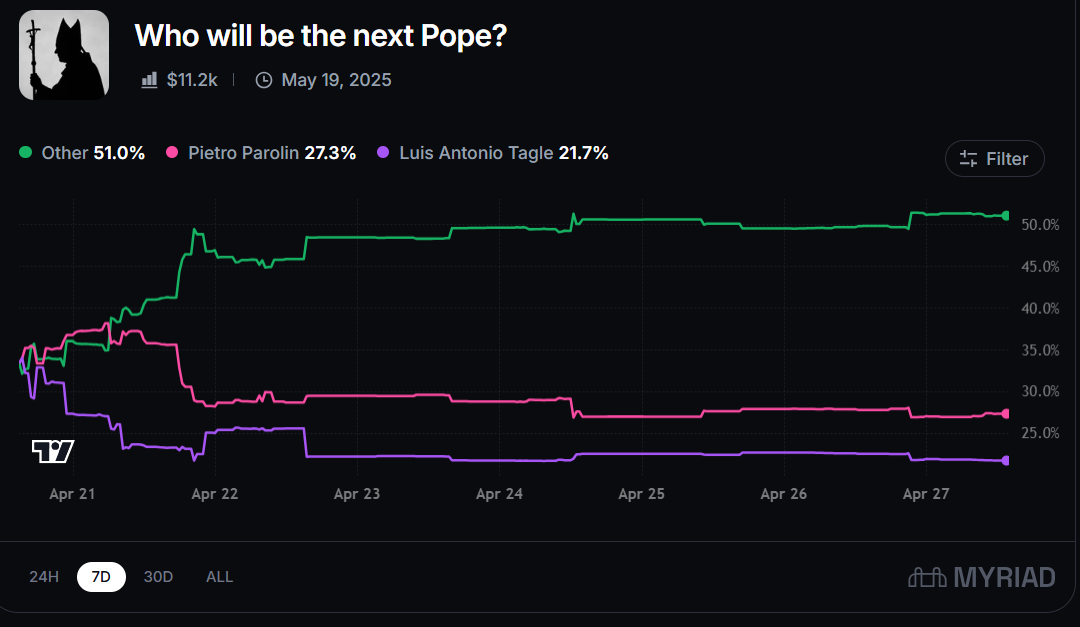
Sentiment at Polymarket is pretty much the same as Myriad, with Pietro Parolin having 28% of the votes, followed by Tagle with 21%.
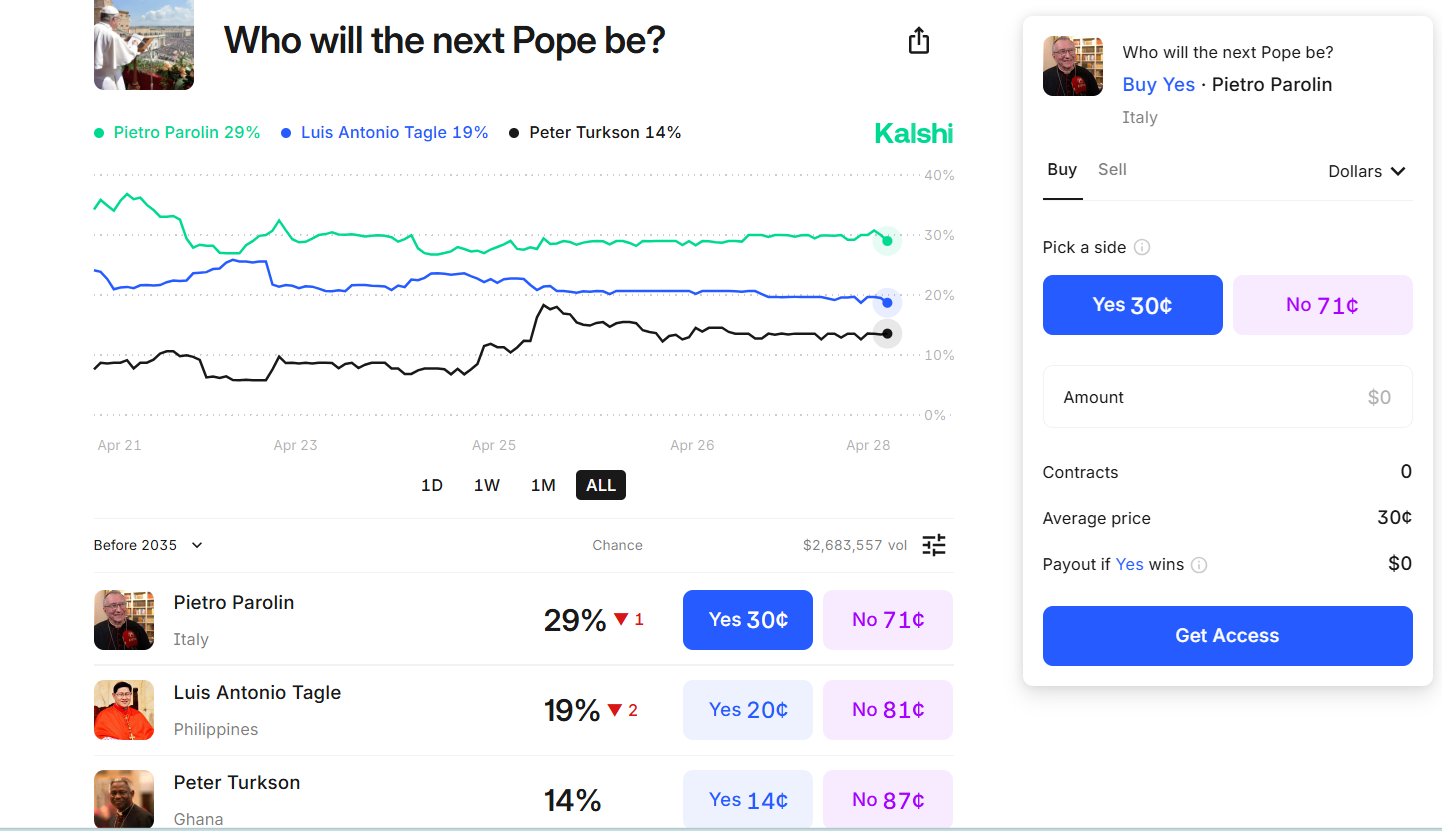
Kalshi Markets also has Parolin leading the race, with Tagle slightly behind. Turkson and Zuppi are tied in third place, just like at Polymarket.
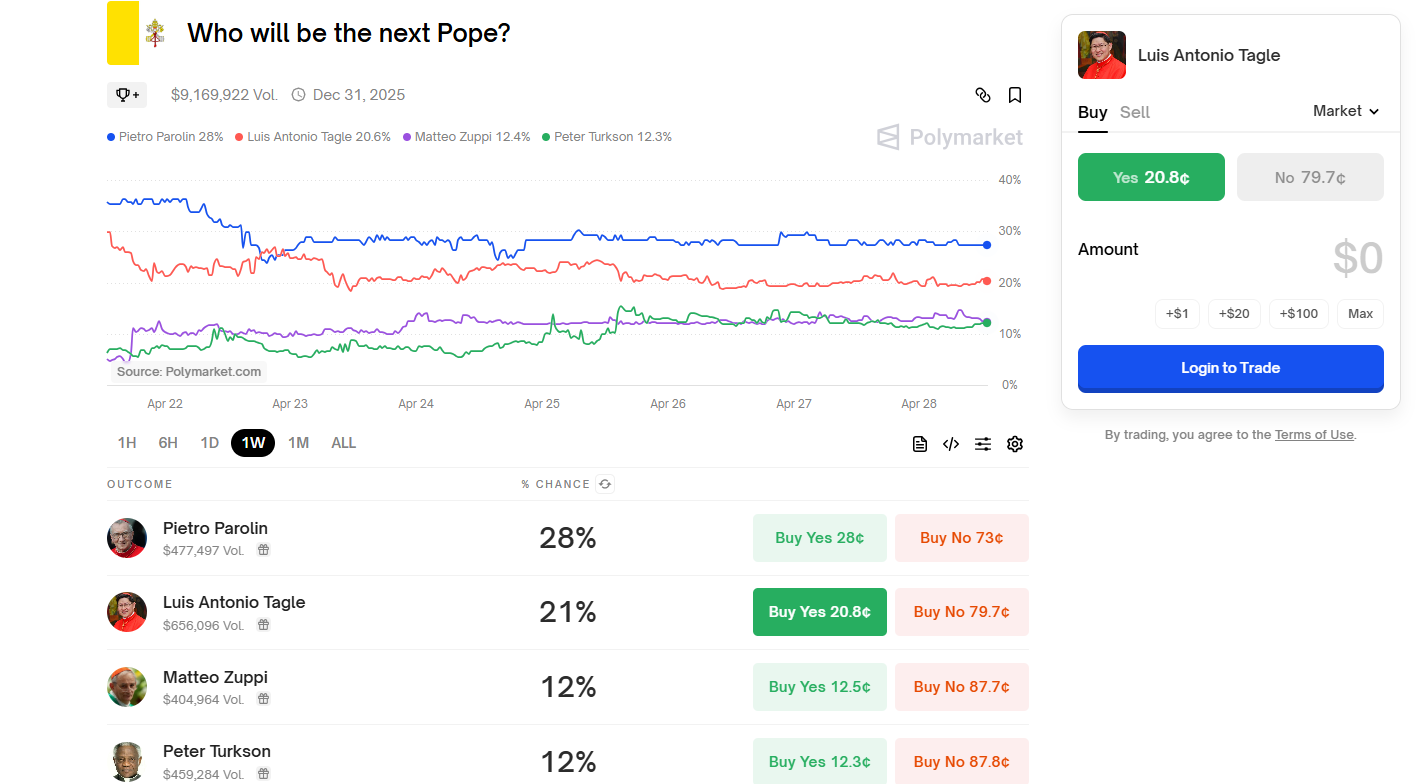
What explains this divergence?
The gap between algorithmic assessment and betting markets could be explained by the kind of information handled and how it’s analyzed. Bettors have a lot more information at hand—including what’s not digitally, or publicly available. They may also be considering traditional odds-making wisdom and historical precedent.
The AI models could only analyze publicly available information, missing the personal relationships, private conversations, and spiritual discernment that will ultimately shape the cardinals' votes.
There could also be some bias involved. Betting markets may be incorporating the conclave’s historical tendency toward compromise candidates. The AI assessments didn’t really take this into consideration to evaluate their predictions—or at least it wasn’t mentioned by the models during their reasoning.
There’s an old Vatican saying that “he who enters the conclave as pope, emerges as a cardinal” and betting markets may be considering this, seeing Parolin as a consensus candidate instead of the first choice by those voting on the conclave—which was the criteria used by many of our AI models.
Regarding the question of who would be the best Pope, the decision is much more apparent with Cardinal Luis Antonio Tagle taking nearly two-thirds of the votes.
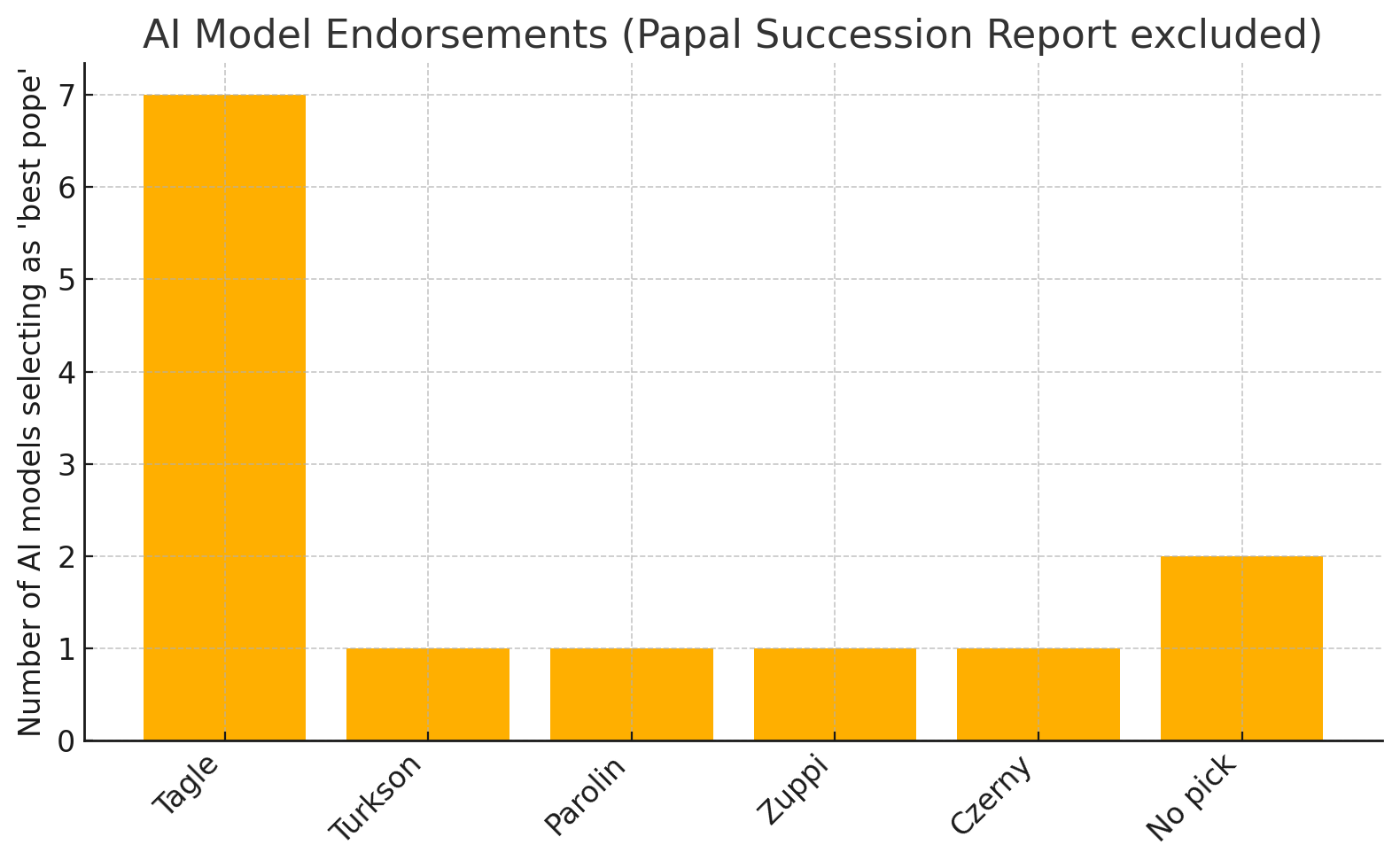
Whether the actual College of Cardinals will reach the same conclusion remains to be seen. No AI model asked for divine inspiration.
免责声明:本文章仅代表作者个人观点,不代表本平台的立场和观点。本文章仅供信息分享,不构成对任何人的任何投资建议。用户与作者之间的任何争议,与本平台无关。如网页中刊载的文章或图片涉及侵权,请提供相关的权利证明和身份证明发送邮件到support@aicoin.com,本平台相关工作人员将会进行核查。




